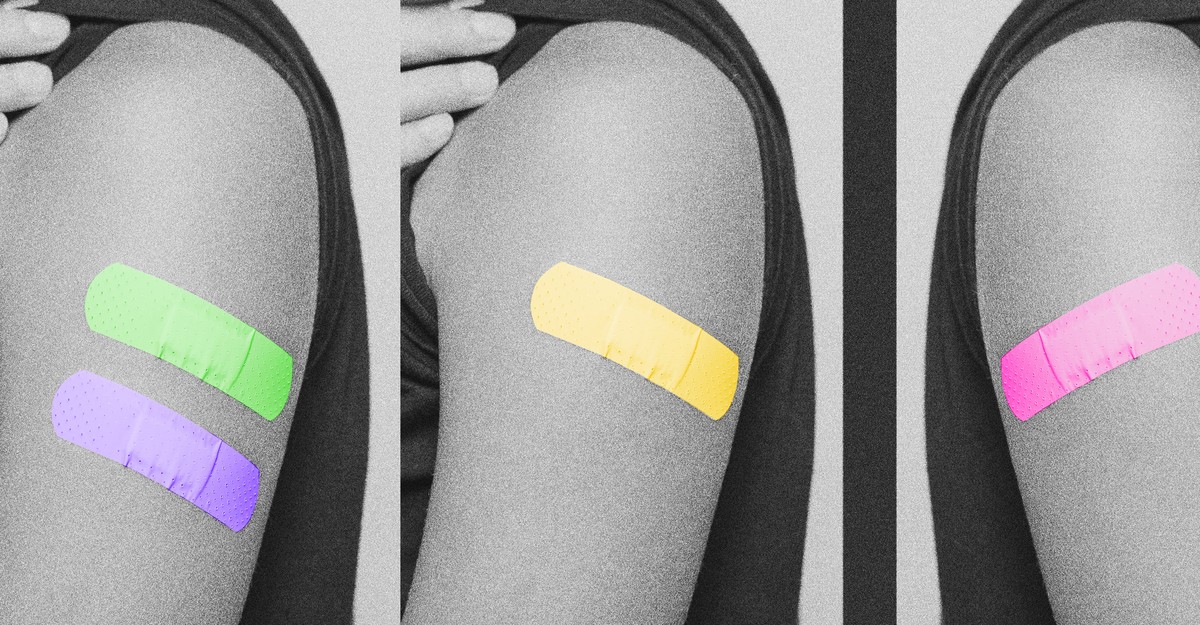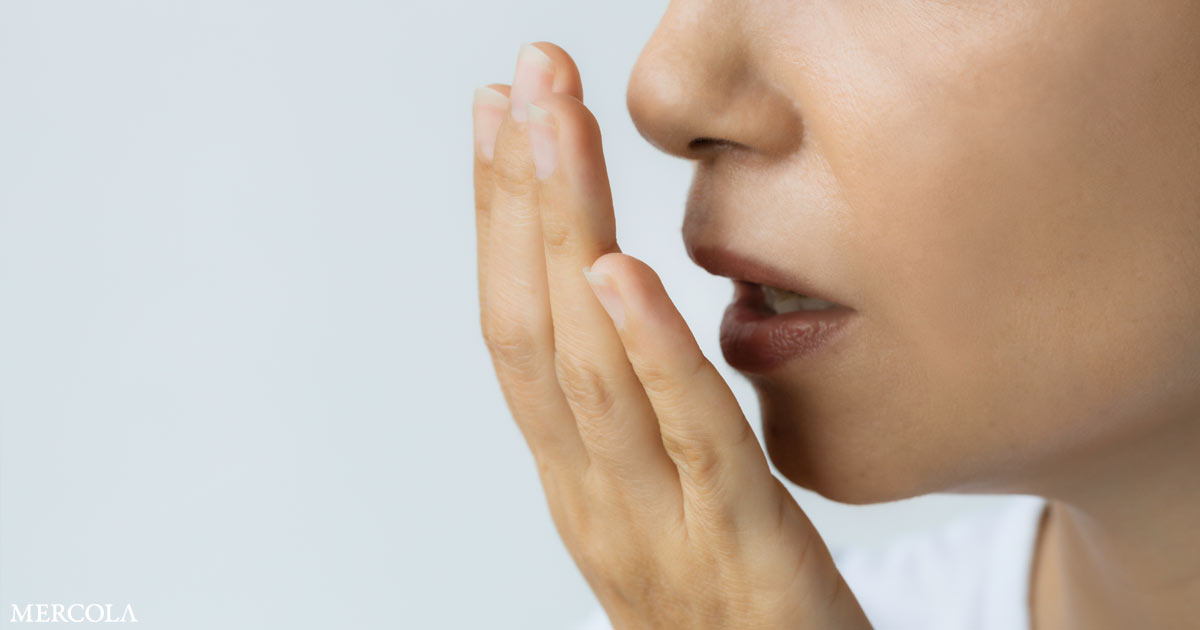
[ad_1]
At a press briefing earlier this month, Ashish Jha, the White House’s COVID czar, laid out some pretty lofty expectations for America’s immunity this fall. “Millions” of Americans, he said, would be flocking to pharmacies for the newest version of the COVID vaccine in September and October, at the same appointment where they’d get their yearly flu shot. “It’s actually a good idea,” he told the press. “I really believe this is why God gave us two arms.”
That’s how I got immunized last week at my local CVS: COVID shot on the left, flu shot on the right. I spent the next day or so nursing not one but two achy upper arms. Reaching high shelves was hard; putting on deodorant was worse. And it did make me wonder what would have happened if I’d ignored Jha’s teleological advice and gotten both jabs in the same arm. Maybe my annoyance would have been lessened. Or perhaps the same-side shots would have made the soreness in my left arm way worse. When I posed this puzzle to immunologists, vaccinologists, and pharmacists, I got back a lot of hems and haws. For the millions of Americans who will be getting two-shot appointments by fall’s end, they told me, the choice really does come down to personal preference in the absence of clear data: You’ve just gotta pick a side. Or, you know, two.
On the one hand (sorry), there are the vaccine double-downers. Sallie Permar, a pediatrician at Cornell University, and Stephanie Langel, an immunologist at Duke University, both said they’d probably get both shots in the same shoulder; so would Rishi Goel, an immunologist at the University of Pennsylvania. “Personally, I’d rather have one arm that’s slightly uncomfortable than both,” Goel told me.
On the other hand, we’ve got Team Divide-and-Conquer. Several experts said they’d follow the White House protocol of splitting shots left and right. Ali Ellebedy, an immunologist at Washington University in St. Louis, told me he’d prefer to have two slightly sore arms to one totally dead one. Jacinda Abdul-Mutakabbir, a pharmacist at Loma Linda University, says she generally recommends that her patients get the vaccines on separate sides “for comfort.” Last year, she opted to get the flu shot and a COVID booster within a few inches of each other, and “I wanted to chop my arm off,” she told me. “Never again.”
The deciding logic here should be pretty intuitive, Permar told me. Two shots on one side might be expected to double how sore that arm will get, though the experience of each vaccine recipient will depend on a bevy of factors, including the ingredients in the shots and that person’s infection and vaccination history, as well as their immune-system health. Also, for people like my husband—who’s prone to very heavy vaccine side effects—the choice may not matter at all. He was so knocked out by the fever and chills that came with his COVID-flu-shot combo, he couldn’t have cared less which arms got the shots.
I dug around for studies examining the consequences of the one-versus-two-arm choice and found only one: a Canadian trial from 2003, which vaccinated a few hundred sixth-graders at two dozen middle schools against group C meningitis and hepatitis B at the same time. Roughly half the kids got both shots in the same arm; the others received one on each side. (Some kids in the latter group requested that their shots be administered by a pair of nurses who could plunge both syringes at the same time.) Among students in the same-arm group, 18 percent ended up with tenderness at the injection site that they rated “moderate or severe.” But those kids fared better than the ones in the two-arm group, 28 percent of whom experienced moderate or severe tenderness in at least one arm, and 8 percent of whom had it in both arms at the same time.
But those results apply only to that group of kids in that setting, with those two specific vaccines; there’s no telling whether the same trends would be seen with flu shots and COVID shots when given to children or adults. Michela Locci, an immunologist at the University of Pennsylvania, told me she suspects that combining flu and COVID inoculations in the same arm could actually drive extra side effects: “The overall inflammation might be higher,” she said.
Many pediatricians, who often have to administer four or five shots to a baby at once, are habitual splitters. “If there’s more than one vaccine syringe to give to a baby, generally, two legs are used,” Permar told me. (Kids usually upgrade to arm shots sometime in toddlerhood—it’s all about finding a muscle that’s big enough for the needle to hit its mark.) Doctors also have a nerdy reason to split shots between arms or legs. “If there’s a local reaction to the vaccine,” Permar said, “you can identify which vaccine it was if you separate them by space.” (For the record, I had a more painful reaction in my left arm, where I got the COVID shot. Others I’ve spoken with have reported the same disparity.)
The CDC advocates for separating vaccination shots by at least one inch of space. Per the agency, if a COVID shot is being given at the same time as a vaccine “that might be more likely to cause a local injection site reaction,” the shots should be dosed into “different limbs, if possible.” Two types of flu shots cleared for use in people 65 years and older—the high-dose vaccine and the adjuvanted one—fall into that category. But the different-limb advice doesn’t seem to apply to other flu shots, including those cleared for use in younger adults and kids.
However someone ends up taking simultaneous flu and COVID shots, the placement is unlikely to affect how much protection the vaccines provide. There could be an argument for letting “each side focus on its own thing,” says Gabriel Victora, an immunologist at Rockefeller University. “But it probably doesn’t make a whole lot of difference.” Children routinely get combo vaccines, such as DTaP and MMR, each of which combines multiple disease-fighting ingredients in a single syringe. The triple-threat formulas work just as well as injecting their individual parts. The immune system is used to multitasking: It spends all day being bombarded by microbes, so there’s good reason to believe that with vaccines, too, our body will see simultaneous shots “as independent events,” Goel told me.
Which arm gets picked for which shot, though, will affect where the jab’s contents end up. After a vaccine is injected, its immunity-inducing ingredients meander to the nearest lymph node, such as the ones in the armpits. There, hordes of immune cells fight over the vaccine’s bits, and the fittest and fiercest among them are selected to leave the lymph node and fight. Here, again, doubling up on one arm shouldn’t be an issue, Goel said: The immune-cell boot camps in these lymph nodes have “a good amount of real estate.”
It might even be a good idea to stick the same limb—and thereby, the same lymph node—every time you get another dose of a particular vaccine. After immune cells in a lymph node spot a particular bit of pathogen, some of them march off into battle, but others may hang around like reserve troops, mulling over what they’ve learned. A couple of recent studies, one of them in mice, hint that repeated delivery of the same ingredients to those veteran learners could give the body a slight edge—though the extent of that advantage “might be marginal,” Victora told me. Still, Langel, of Duke, told me jokingly that because she usually gets all of her vaccines in her “non-writing” arm, the lymph node beneath it could now be especially superpowered—a “nice bonus” for her defenses on the whole.
That said, no one should stress too much about getting a shot in the “wrong” arm. “It’s not like you’re immune on the left side and not on the right side,” Goel told me. Immune cells travel throughout the body; there is no midline DMZ. Permar even points out that getting the newly formulated COVID vaccine, which includes new ingredients tailored to fight Omicron subvariants, on the opposite side from the previous rounds could help its ingredients reach a fresher slate of cells. “I think you could convince yourself either way,” she told me. Which, honestly, leaves me totally at peace with my choice. Apart from arm achiness, I had no other side effects—and in a way, I preferred the symmetry of the one-on-each-side injections.
With all that said, it’s worth briefly acknowledging a third option: Splitting the flu and COVID vaccines into separate visits. I was, before my most recent COVID shot, some 10 months out from my previous dose. But it felt awfully early for my flu shot, which might be better timed for peak protection if taken later in the season. Still, the allure of getting it all over with was too tantalizing, especially because I happen to have a lot of travel up ahead. In the grand scheme of things, the bigger, more important choice was opting into the shots at all.
[ad_2]
Source link





No comment yet, add your voice below!